Trenches
Hollywood Exodus
By SAMIR S. PATEL
Monday, December 15, 2014
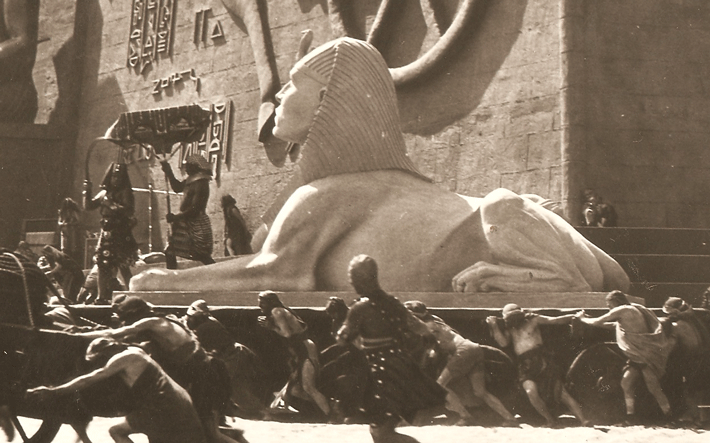
If there’s one thing that the pharaohs of ancient Egypt had in common with legendary filmmaker Cecil B. DeMille, it was an eye for spectacle. Remains of the pharaohs’ grand ambitions have stood in the Egyptian desert for thousands of years. Now, some remains of DeMille’s vision have emerged from the Guadalupe-Nipomo Dunes on the central California coast.
For the 1923 silent film The Ten Commandments (remade by DeMille himself in 1956 with both sound and Charlton Heston), DeMille had workers create a massive set in the dunes, including a 120-foot-tall gate flanked by four statues of Ramesses II and 21 sphinxes. Legend has it that the set was destroyed, but over the years archaeologists—amateur and professional—have uncovered remains from the production and hints that the hollow plaster sphinx statues still lie in situ.
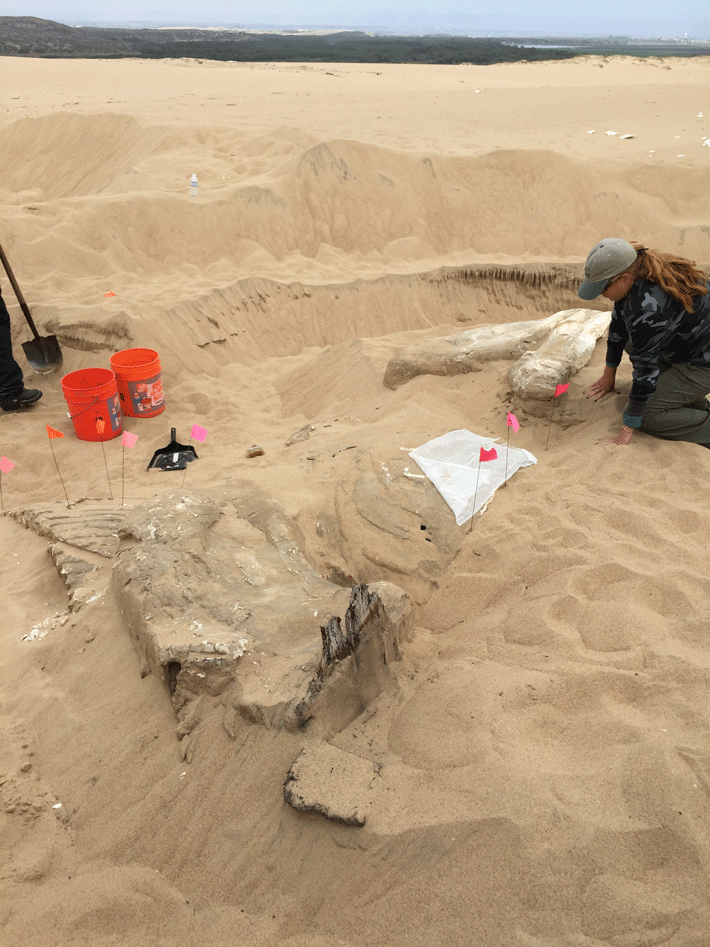 In 2012, the head of one sphinx was excavated, and recently archaeologists from Allied Earthworks, working with the Guadalupe-Nipomo Dunes Center, have excavated the crumbling, weather-beaten body of another. Using the original silent epic to guide their work, the excavators delicately exposed and stabilized the crumbling plaster, which will now be reconstructed for display. “If 1,000 years from now, archaeologists happen to dig beneath the sands of Guadalupe,” wrote DeMille in his 1959 autobiography, “I hope they will not rush into print with the amazing news that Egyptian civilization, far from being confined to the Valley of the Nile, extended all the way to the Pacific coast of North America.”
In 2012, the head of one sphinx was excavated, and recently archaeologists from Allied Earthworks, working with the Guadalupe-Nipomo Dunes Center, have excavated the crumbling, weather-beaten body of another. Using the original silent epic to guide their work, the excavators delicately exposed and stabilized the crumbling plaster, which will now be reconstructed for display. “If 1,000 years from now, archaeologists happen to dig beneath the sands of Guadalupe,” wrote DeMille in his 1959 autobiography, “I hope they will not rush into print with the amazing news that Egyptian civilization, far from being confined to the Valley of the Nile, extended all the way to the Pacific coast of North America.”
Symbolic Neanderthals
By ZACH ZORICH
Monday, December 15, 2014
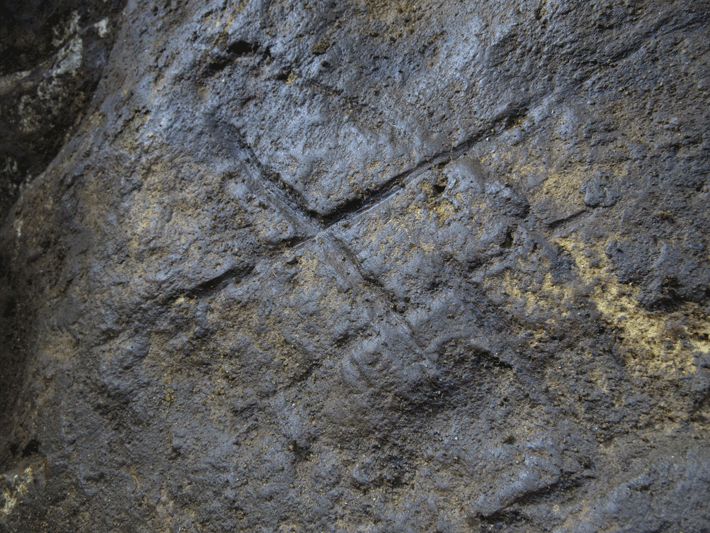 An artistic design made up of overlapping lines carved on a cave wall was discovered buried under sediment containing Neanderthal artifacts in Gorham’s Cave, Gibraltar. Paleolithic art expert Francesco d’Errico of the University of Bordeaux analyzed the engraving and reproduced the process of making it. His analysis shows that a stone tool was used, and that each line was carved precisely, indicating that it was made by an experienced artist. The design at Gorham’s Cave is the clearest evidence yet that Neanderthals made artwork, but whatever meaning it carried has been lost in time. “They had the cognitive ability to develop symbolic behavior,” says d’Errico, “but it was in a form which was different from what we see later on in history.”
An artistic design made up of overlapping lines carved on a cave wall was discovered buried under sediment containing Neanderthal artifacts in Gorham’s Cave, Gibraltar. Paleolithic art expert Francesco d’Errico of the University of Bordeaux analyzed the engraving and reproduced the process of making it. His analysis shows that a stone tool was used, and that each line was carved precisely, indicating that it was made by an experienced artist. The design at Gorham’s Cave is the clearest evidence yet that Neanderthals made artwork, but whatever meaning it carried has been lost in time. “They had the cognitive ability to develop symbolic behavior,” says d’Errico, “but it was in a form which was different from what we see later on in history.”
The King is Dead. Long Live the King
Monday, December 15, 2014
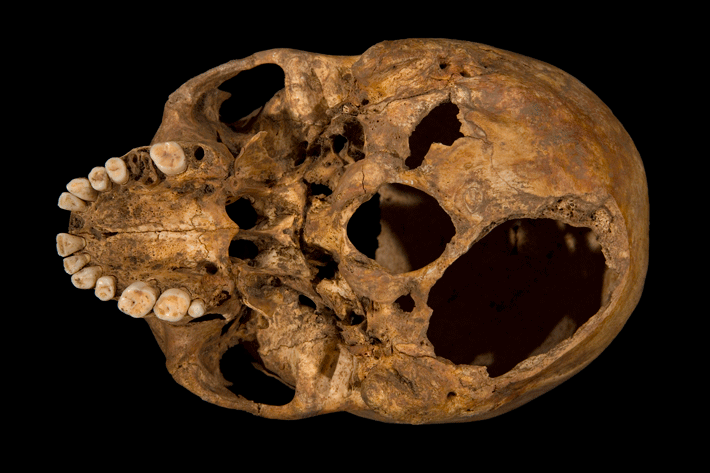 The skeleton of Richard III, discovered in 2012, is continuing an active afterlife as it makes its way from the ground beneath a parking lot to an elaborate new tomb in Leicester Cathedral. Recently published isotope analysis of two teeth, a femur, and a rib from the skeleton is revealing the diet of the much-maligned late-medieval monarch throughout his life. Results indicate that he likely moved during childhood and later enjoyed an aristocratic diet that grew notably richer (with fresh fish and wildfowl, including swans) upon his ascension to the throne. In particular, researchers from the British Geological Survey inferred from oxygen isotope data that, once he became king, Richard drank a truly prodigious quantity of imported wine—a quarter of his total fluid intake. As the course of his life is established, so too are the gruesome events of his death. It was clear upon his exhumation that he died a violent death, but detailed examination of his remains shows just how violent. He suffered at least 11 major wounds, nine of them to the skull, including a dagger wound to the cheek, a penetrating injury to the top of the head, and two potentially fatal slices at the base of the skull. According to study author Sarah Hainsworth of the University of Leicester, the injuries suggest a sustained attack, perhaps by several assailants, and that the king was not wearing a helmet.
The skeleton of Richard III, discovered in 2012, is continuing an active afterlife as it makes its way from the ground beneath a parking lot to an elaborate new tomb in Leicester Cathedral. Recently published isotope analysis of two teeth, a femur, and a rib from the skeleton is revealing the diet of the much-maligned late-medieval monarch throughout his life. Results indicate that he likely moved during childhood and later enjoyed an aristocratic diet that grew notably richer (with fresh fish and wildfowl, including swans) upon his ascension to the throne. In particular, researchers from the British Geological Survey inferred from oxygen isotope data that, once he became king, Richard drank a truly prodigious quantity of imported wine—a quarter of his total fluid intake. As the course of his life is established, so too are the gruesome events of his death. It was clear upon his exhumation that he died a violent death, but detailed examination of his remains shows just how violent. He suffered at least 11 major wounds, nine of them to the skull, including a dagger wound to the cheek, a penetrating injury to the top of the head, and two potentially fatal slices at the base of the skull. According to study author Sarah Hainsworth of the University of Leicester, the injuries suggest a sustained attack, perhaps by several assailants, and that the king was not wearing a helmet.
Cults of the Bronze Age
By JARRETT A. LOBELL
Monday, December 15, 2014
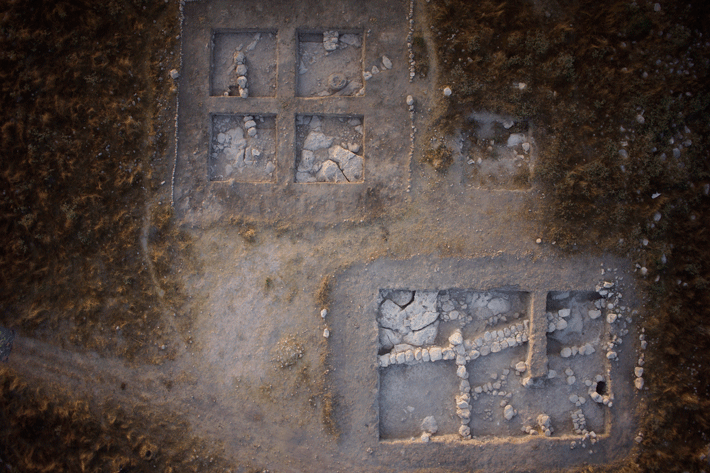
Despite its location at the heart of the Shephelah, one of Israel’s most intensively researched regions, the site of Tel Burna had never been excavated. Scholars assumed that there was little there to uncover. But a team led by Itzhaq Shai from Ariel University has discovered, only a few inches below the surface, an abundance of objects, including dozens of beads, a cylinder seal and scarab, goblets, zoomorphic figurines, chalices, and ceramic masks, all within the remains of a large public building.
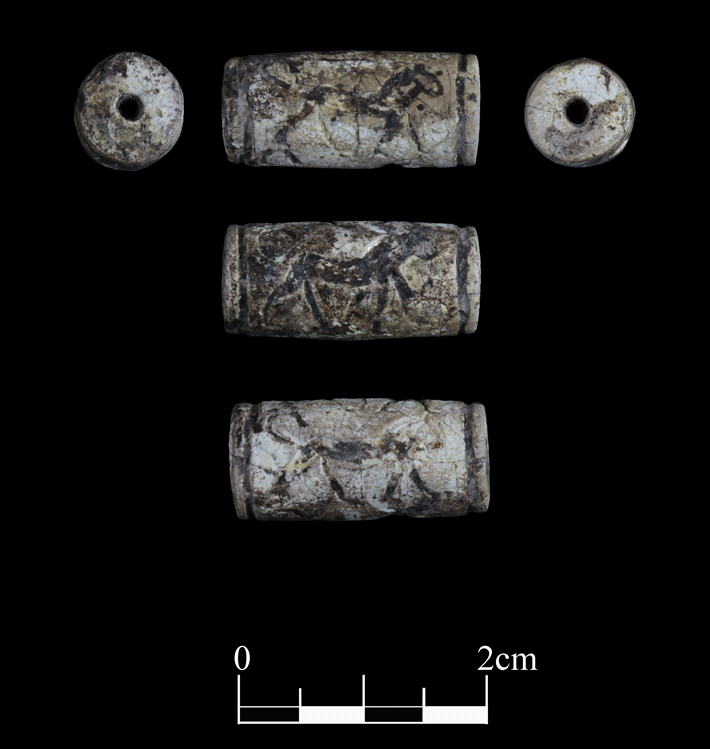 Shai believes that the presence of so many ceremonial items indicates that the structure, which dates to the thirteenth century B.C. and measures more than 5,000 square feet, was an important public space where cultic activities, including feasting, burning incense or other aromatics, offering of votives, and religious processions employing the masks took place. The team also found two very large ceramic pithoi (storage vessels) that were imported from Cyprus, and were likely used to safeguard the religious complex’s tithes or, perhaps, store food for use in cultic activities. The complex at Tel Burna may also have had administrative functions for the larger settlement in the Late Bronze Age, when it covered about 15 acres on the border between the ancient territories of Judah and Philistia.
Shai believes that the presence of so many ceremonial items indicates that the structure, which dates to the thirteenth century B.C. and measures more than 5,000 square feet, was an important public space where cultic activities, including feasting, burning incense or other aromatics, offering of votives, and religious processions employing the masks took place. The team also found two very large ceramic pithoi (storage vessels) that were imported from Cyprus, and were likely used to safeguard the religious complex’s tithes or, perhaps, store food for use in cultic activities. The complex at Tel Burna may also have had administrative functions for the larger settlement in the Late Bronze Age, when it covered about 15 acres on the border between the ancient territories of Judah and Philistia.
Fancy Footwear
By HYUNG-EUN KIM
Monday, December 15, 2014
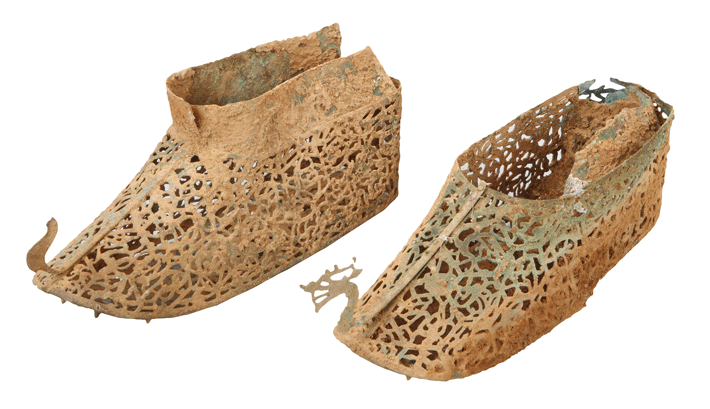
A team of archaeologists from the Naju National Research Institute of Cultural Heritage in South Korea’s South Jeolla Province has uncovered a remarkable pair of shoes in a tomb. The gilt-bronze shoes date to the fifth century A.D. and are the best preserved of only 17 similar pairs found in the country. They are also the most elaborately decorated, with images of lotus flowers and goblin-like creatures covering the surface, and a dragon leaping from each toe. Because they are oversized and not very sturdy, archaeologists believe the shoes weren’t for daily wear, but rather for a burial ritual, perhaps reflecting the hope that the dead’s spirit would rise to a better place. In addition to the shoes, the team also uncovered gold jewelry, jade, weapons, a harness, and pottery, suggesting that the tomb’s occupant was likely one of the rulers of Mahan, a confederacy of statelets that existed beginning in the first century B.C. at the southern end of the peninsula, alongside the more famous Three Kingdoms of Goguryeo, Silla, and Baekje. The shoes, which are Baekje-style, were likely a gift to the Mahan ruler.
Advertisement
Advertisement
IN THIS ISSUE
Trenches
The Price of Plunder
Off The Grid
A Tale of Two Railroads
On the Origins of Art
Fancy Footwear
The King is Dead. Long Live the King
Cults of the Bronze Age
Symbolic Neanderthals
Hollywood Exodus
Egypt's Disappearing Animals
Across the Atlantic by Flipper
Viking Treasure Trove
Paleo-escargot
Maya Cities Lost and Found
Advertisement

Recent Issues
-
 May/June 2024
May/June 2024
-
 March/April 2024
March/April 2024
-
 January/February 2024
January/February 2024
-
 November/December 2023
November/December 2023
-
 September/October 2023
September/October 2023
-
 July/August 2023
July/August 2023
-
 May/June 2023
May/June 2023
-
 March/April 2023
March/April 2023
-
 January/February 2023
January/February 2023
-
 November/December 2022
November/December 2022
-
 September/October 2022
September/October 2022
-
 July/August 2022
July/August 2022
-
 May/June 2022
May/June 2022
-
 March/April 2022
March/April 2022
-
 January/February 2022
January/February 2022
-
 November/December 2021
November/December 2021
-
 September/October 2021
September/October 2021
-
 July/August 2021
July/August 2021
-
 May/June 2021
May/June 2021
-
 March/April 2021
March/April 2021
-
 January/February 2021
January/February 2021
-
 November/December 2020
November/December 2020
-
 September/October 2020
September/October 2020
-
 July/August 2020
July/August 2020
-
 May/June 2020
May/June 2020
-
 March/April 2020
March/April 2020
-
 January/February 2020
January/February 2020
-
 November/December 2019
November/December 2019
-
 September/October 2019
September/October 2019
-
 July/August 2019
July/August 2019
-
 May/June 2019
May/June 2019
-
 March/April 2019
March/April 2019
-
 January/February 2019
January/February 2019
-
 November/December 2018
November/December 2018
-
 September/October 2018
September/October 2018
-
 July/August 2018
July/August 2018
-
 May/June 2018
May/June 2018
-
 March/April 2018
March/April 2018
-
 January/February 2018
January/February 2018
-
 November/December 2017
November/December 2017
-
 September/October 2017
September/October 2017
-
 July/August 2017
July/August 2017
-
 May/June 2017
May/June 2017
-
 March/April 2017
March/April 2017
-
 January/February 2017
January/February 2017
-
 November/December 2016
November/December 2016
-
 September/October 2016
September/October 2016
-
 July/August 2016
July/August 2016
-
 May/June 2016
May/June 2016
-
 March/April 2016
March/April 2016
-
 January/February 2016
January/February 2016
-
 November/December 2015
November/December 2015
-
 September/October 2015
September/October 2015
-
 July/August 2015
July/August 2015
-
 May/June 2015
May/June 2015
-
 March/April 2015
March/April 2015
-
 January/February 2015
January/February 2015
-
 November/December 2014
November/December 2014
-
 September/October 2014
September/October 2014
-
 July/August 2014
July/August 2014
-
 May/June 2014
May/June 2014
-
 March/April 2014
March/April 2014
-
 January/February 2014
January/February 2014
-
 November/December 2013
November/December 2013
-
 September/October 2013
September/October 2013
-
 July/August 2013
July/August 2013
-
 May/June 2013
May/June 2013
-
 March/April 2013
March/April 2013
-
 January/February 2013
January/February 2013
-
 November/December 2012
November/December 2012
-
 September/October 2012
September/October 2012
-
 July/August 2012
July/August 2012
-
 May/June 2012
May/June 2012
-
 March/April 2012
March/April 2012
-
 January/February 2012
January/February 2012
-
 November/December 2011
November/December 2011
-
 September/October 2011
September/October 2011
-
 July/August 2011
July/August 2011
-
 May/June 2011
May/June 2011
-
 March/April 2011
March/April 2011
-
 January/February 2011
January/February 2011
Advertisement






